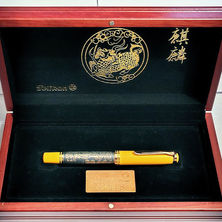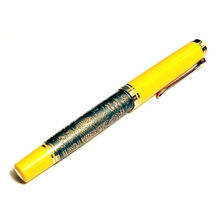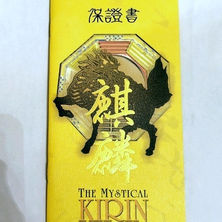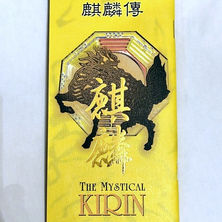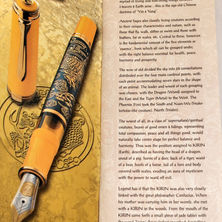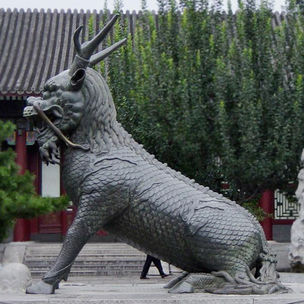top of page
Pelikan Kirin (2002) - Asia Limited Edition
The fifth and the last release of the Asia Limited Edition was the Kirin (2002), based on the motif of Kirin, the legendary Chinese animal.
According to ancient Chinese mythology, there are guardian deities in the four directions in the sky, and all creatures are said to belong to each guardian deity according to their nature and characteristics. The guardian deities of the four directions are called the "Four Gods": the Azure Dragon in the East, the White Tiger in the West, the Vermilion Phoenix in the South, and Xuanwu (Black Tortoise-Snake) in the North. In accordance with the "Wuxing" (Five Phases Theory), the Yellow Qilin (Kirin) was added in the center to make up the number "five". When the Golden Dynasty was first released as the Asia Limited Edition, fountain pen enthusiasts all would have thought that it would become the "Four" Gods series, but in the end, "five" fountain pens were released. The reason was as described above.
The Kirin is written in Chinese characters as "麒麟". Originally "麒"(ki) represented the male Kirin and "麟"(rin), the female Kirin. The Kirin is a mythical animal that appears in ancient Chinese myths and legends. They are mild-mannered and rarely trample insects, flowers, or plants. They have horns that can be used as weapons to attack enemies, but at the end of the horns is a lump of meat, and although they have weapons, they do not actually harm people or animals. For this reason, it is called a benevolent animal. According to legend, it is called the animal of fortune because it appears only in times of peace and prosperity and in the presence of saints.
Confucius ”孔子” has a close relationship with the Kirin. According to his Spring and Autumn Annals, "in the spring of the 14th year of the Duke of Ai in Lu, while the Duke of Ai was hunting in the west, a wild animal was caught, which the people thought was ‘ominous’ and thrown away the body, because they had never seen such an animal before." Seeing the animal, Confucius said, this is a "麟"(rin; female Kirin) (Shiji”史記"). Learning that the Kirin had appeared at a time when there were no saints and the world was not at peace, and that the people who had captured it did not know that it was a Kirin, he is said to have been deeply disappointed, lamenting that his previous deed was in vain and that his Tao ”道” had came to a dead end. His Spring and Autumn Annals ends with the so-called "Kirin” article. From this event, "獲麟" (capturing Kirin) came to mean the end of things (esp. used for one's last writings).
The original image of the Kirin in ancient times was that of a one-horned hairy animal with the body of a deer, the tail of an ox (中国政法大学博物館). In literature of the Tang and pre-Song dynasties, Kirin were often described as a hairy animal without scales. Through the Song, Yuan, Ming, and Qing dynasties to the present day, the image of the Kirin has gradually changed. The head of a deer (horse) became the head of a dragon, one horn became two horns, and finally, the image was completely transformed into what people believe today: a dragon head, two horns, a deer or horse body, and scales. Thus, the image of the Kirin has changed from that of the Kirin, which is reminiscent of the ancient benevolent saintly monarchs of the Han and Tang dynasties, to the majestic dragon-like figures of the Ming and Qing dynasties.
During the Ming Dynasty, Zheng He "鄭和", who sailed the South Sea seven times during his lifetime, brought back a giraffe from East Africa and presented it to the Yongle Emperor "永楽帝". Although its authenticity is not known, the Yongle Emperor took a liking to the giraffe, and it is said that he prized it as a “real Kirin” because of its resemblance to the legendary Kirin and because the pronunciation of the local Somali word “geri,” meaning "a long-necked herbivore sounded like ‘Kirin’. Since then, the legendary image of the Kirin became associated with the image of the giraffe⁽¹⁾.
The animal that could be compared to the Kirin in the West would be the unicorn, which has the same single horn, but differs in the shape of its horn, its character, and its origin. The Kirin is a legendary creature from Chinese mythology, while the unicorn is a legendary creature from the Old Testament and other sources. Unicorns have sharp horns, while Kirin have rounded ends on their horns. The unicorn is a very fierce creature with a horn that can pierce anything. On the other hand, the Kirin is very gentle and the tip of its horn is rounded to prevent it from hurting people.
For this Kirin fountain pen, the body color has returned to a pure color, vivid yellow, to match the Kirin in the Five Phases Theory. In addition, while the ink window color in the previous series was translucent gray regardless of the body color, the color of the ink window in the Kirin is translucent yellow, which matches the body color and is very beautiful (Fig.3-4). The Kirin is a fitting end to the Asia Limited Series.
The packaging is similar to the Xuan Wu, with a wooden inner box. The inner box has the word “麒麟” and the "modern image" of Kirin, engraved on the lid. Like the Xuan Wu, it comes with a cloth bag to wrap the inner box. The outer box that holds the inner box is made of paper and is almost the same size as the inner box.
Note;⁽¹⁾In this connection, when naturalists of the Meiji era established a translation of "giraffe" in Japan, 麒麟 (kirin) was suggested as a possible translation, and “麒麟” was finally adopted.
Kirin
My collection.
Various "Kirin" images
bottom of page



